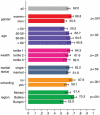Pain Is Widespread and Predicts Poor Mental Health Among Older Adults in Rural Malawi
- PMID: 35542563
- PMCID: PMC9074811
- DOI: 10.1093/geroni/igac008
Pain Is Widespread and Predicts Poor Mental Health Among Older Adults in Rural Malawi
Abstract
Background and objectives: Pain is common among older persons and has been documented as an important predictor of disability, health, and economic outcomes. Evidence about its prevalence and relationship to well-being is scarce in rural sub-Saharan Africa (SSA), where work is frequently physically demanding, and pain prevention or treatment options are limited. We investigate the prevalence of pain and its association with mental health and subjective well-being in a population-based study of older adults in rural Malawi.
Research design and methods: We estimate the prevalence, severity, and duration of pain along with its sociodemographic distribution in a sample of 1,577 individuals aged 45 and older. We assess the association of pain with clinically validated measures of mental health, including depression and anxiety, and subjective well-being.
Results: Pain is widespread in this mature population with an average age of 60 years: 62% of respondents report the experience of at least minor pain during the last year, and half of these cases report severe or disabling pain. Women are more likely to report pain than men. Pain is a strong predictor of mental health and subjective well-being for both genders. More severe or longer pain episodes are associated with worse mental states. Individuals reporting pain are more likely to suffer from depression or express suicidal thoughts.
Discussion and implications: Our study identifies key subpopulations such as older women in a SSA low-income context who are particularly affected by the experience of pain in daily life and calls for interventions targeting pain and its consequences for mental health and subjective well-being.
Keywords: Depression; Gender differences; PHQ-9; Physical health; Sub-Saharan Africa.
© The Author(s) 2022. Published by Oxford University Press on behalf of The Gerontological Society of America.
Figures
References
-
- Aboderin, I. (2010). Understanding and advancing the health of older populations in sub-Saharan Africa: Policy perspectives and evidence needs. Public Health Reviews, 32, 357–376. doi:10.1007/BF03391607 - DOI
Grants and funding
LinkOut - more resources
Full Text Sources
Research Materials


